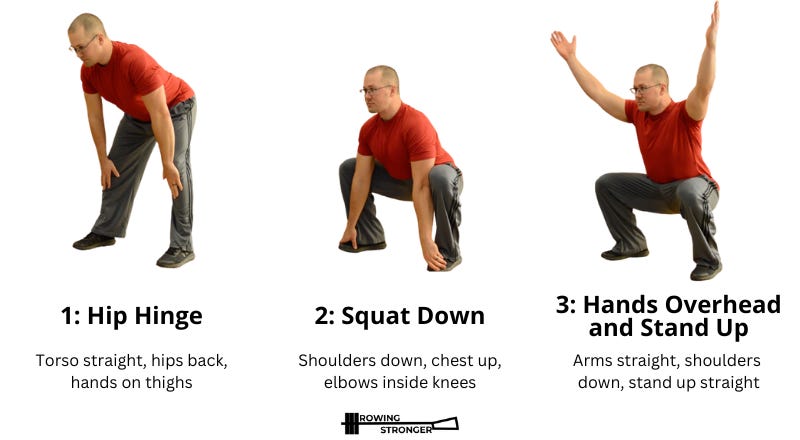If you’re only going to do one movement from the full-body warmup routine before erging, rowing, and strength training, the deep squat progression is the one to do.
I learned this movement during my very first coaching job in undergrad, a year-long internship with the varsity track and field team, and have been using it myself and in my coaching ever since. It’s the finale of my warm-up routine, and also a useful movement by itself whenever an occasion calls for mobilizing and light bodyweight strength training.
For example, when we drove the 18 hours from Western Washington University to Sacramento for the WIRA Championships on Lake Natoma, rowers would dismount the passenger vans at gas stations and rest stops for deep squat progressions to stave off the ache of travel.
Key technique pointers:
Stick each position for a second before moving to the next position in the progression.
Hinge position: Hands on thighs, knees unlocked but not deeply bent, push hips backwards for the hinge-based dynamic hamstring stretch.
Bottom position: Hands over midfoot and elbows inside knees, lightly pushing out to stretch the groin muscles and sink deeper into the squat with chest up, shoulders down, and weight balanced between forefoot and hindfoot.
Hands up: Stay in the bottom squat position while raising hands up, keeping the shoulders down to feel the mid-back muscles activating.
Stand up: Stand up straight with no rounding of the back or early rising of the hips. Feel this primarily in the quadriceps muscles to prepare for performance.
A single set of 10 reps with a good pause in each position should get a light sweat beginning, muscles ready to perform, and a bit of land-based effort before transitioning to the water, erg, or whatever is next. I recommend doing the rest of the full-body warm-up as well, but if you only have time or desire for one thing, this is the one. Watch the deep squat progression in action below.






